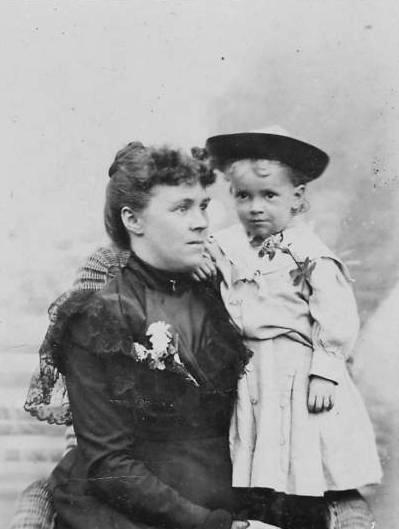
American Boy Skirted Garments: Accompanying Clothes

Figure 1.--This cabinet portrait comes from a small Maine sale. The portrait is not unidentified, but the clothing and mount styles suggests the 1890s. Note the upturned sailor hat which probably had a rounded crown. The boy seems to be wearing a dress, but it is not entirely clear.
|
|
American boys wore a range of garments with skirted garments. This of course varied with the tyoe of skirted garments. Skirts and kilts required, for example, blouses and skirts and there was Scottish-styled headwear to go with kilts. Dresses covered the bodice above the waist. We will cover the specific accompanying garments with individual skirted garments separately. Here we will cover some of the general trends as well as images where the type of skirted garments is not obvious. Our primary source is the photigraphic record, but we hope to gradually include other types of information. We need to cover headwear, neckwear, pants, undergarments, hosiery, and footwear. The available photographic record provides considerable detail about these accompanying garments. One problem with this assessment is that many younger boys had very long skirts, in some cases extended almost to their footwear. We note a wide range of headwear. Neckwear varied, but we see floppy bows in the late-19th century. Some boys wore pants, mostly with with kilt suits and tunics. Undergarments are difficult to assess, but some portraits provide hints. Most American boys wore long stockings with skirted garments. Footwear included both low-cut and high-top styles.
Headwear
We note a wide range of headwear. We notice both caps and hats. Hsts seem more common with dresses, but this may reflect the fsact thst hats were more common in the 19th century when dresses were more commonly worn. There was Scottish-styled headwear to go with kilts, but they were worn with other skirted garments as well.
Neckwear
Neckwear varied, but we see floppy bows in the late-19th century.
Blouses and Shirts
Skirts and kilts required blouses and skirts. Dresses covered the bodice above the waist.
Pants
Some boys wore pants, mostly with with kilt suits and tunics.
Hosiery
Most American boys wore long stockings with skirted garments, but this could vary chronologically and with the type of skirted garments. Dresses were mostly worn with long stiockings in contrast with Europe where socks were more common. Tunics after the turn-of-the 20th century were commonly worn with three-quater socks during the summer. Kilts but not kilt suits were worn with knee socks.
We see boys wearing a range of undergarments with skirted garments. Some boys wore the same undergarments as their sisters. Others wore more boyish garments. And in some cases we see more boyish versions of girls' undergarments. A factor herte is that in the 19th and early-20th century that younger boys might wear the same underwear as girls. Many factyors were involved here, both chronological trends and family conventions. The type of skirted garment was also a factor as was the boy's age. Dresses were worn with both petticoats anhd pantalettes. Boys might wear plainer pantalettes called drawers, but this was not always the case and some girls also wore drawers. Pantalettes were in the early- and mid-19th century worn to show below the hem of the dress, but this was not the case for petticosts. We are not vebtirely sure about skirts. We think that undergarments werre similar to dresses, but we have little actual evidence. Kilts might also be worn with pantalettes and petticoats, but we also see boys wearing knee pants. Tunics were worn with both bloomer knickers and straight-leg knee pants. Smocks were worn with a boy's regulsr trousers.
Footwear
Footwear included both low-cut and high-top styles.
HBC

Navigate the Historic Boys' Clothing Web dress pages:
[Return to the Main U.S. skirted garments page]
[Return to the Main U.S. garment page]
[Pinafores]
[Ringlet curls]
[Smocks]
[Bodice kilts]
[Kilts]
[Fauntleroy dresses]
[Sailor dresses]
[Fancy dresses]
[Dresses: 16th-18th centuries]
[Dresses: Early-Mid-19th century]
[Dresses: Late-19th century]
[Dresses: Early 20th century]
[Difficult images]
[Movie dresses]
Navigate the Boys' Historical Clothing Web Site:
[Introduction]
[Activities]
[Biographies]
[Chronology]
[Clothing styles]
[Countries]
[Bibliographies]
[Contributions]
[Essays]
[FAQs]
[Glossaries]
[Images]
[Links]
[Registration]
[Tools]
[Boys' Clothing Home]
Created: 5:33 PM 7/3/2010
Last updated: 5:33 PM 7/3/2010



